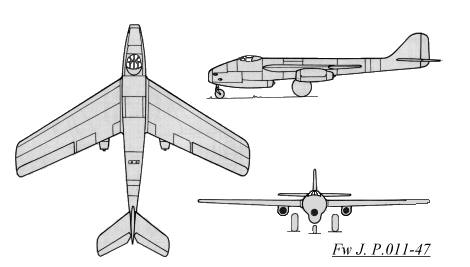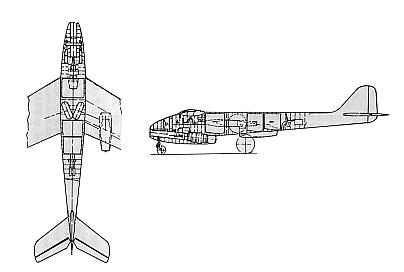 This Focke-Wulf design (also known as Design IV) for a twin-jet nightfighter
also dates from March 19, 1945. The fuselage was to be constructed of Duraluminum,
and the wooden wings contained a steel spar. Like the Design III, the wings
were mounted mid-fuselage and were swept back 30 degrees. Three He S 011
turbojets provided the power, one was located beneath the cockpit in the
forward fuselage and two were mounted under the wings. At least one engine
could be shut down to increase endurance. A crew of three (pilot, radio
operator and navigator) sat in a pressurized cockpit, with the pilot and
navigator sitting side-by-side and the radio operator sitting behind them
and facing to the rear. Armament was similar to that in the Design III,
namely, two MK 108 30mm cannon in the fuselage nose and two MK 108 30mm
cannon firing upwards in the rear fuselage, or four MK 108 30mm cannon
firing forward in the fuselage nose. The influence that Focke-Wulf had
with these night-fighter designs had a definite effect on Soviet aircraft
manufacturers, with the Lavochkin La-200 and MIG I-320 in particular showing
similarities to the earlier Focke-Wulf designs.
This Focke-Wulf design (also known as Design IV) for a twin-jet nightfighter
also dates from March 19, 1945. The fuselage was to be constructed of Duraluminum,
and the wooden wings contained a steel spar. Like the Design III, the wings
were mounted mid-fuselage and were swept back 30 degrees. Three He S 011
turbojets provided the power, one was located beneath the cockpit in the
forward fuselage and two were mounted under the wings. At least one engine
could be shut down to increase endurance. A crew of three (pilot, radio
operator and navigator) sat in a pressurized cockpit, with the pilot and
navigator sitting side-by-side and the radio operator sitting behind them
and facing to the rear. Armament was similar to that in the Design III,
namely, two MK 108 30mm cannon in the fuselage nose and two MK 108 30mm
cannon firing upwards in the rear fuselage, or four MK 108 30mm cannon
firing forward in the fuselage nose. The influence that Focke-Wulf had
with these night-fighter designs had a definite effect on Soviet aircraft
manufacturers, with the Lavochkin La-200 and MIG I-320 in particular showing
similarities to the earlier Focke-Wulf designs.Span: 19.4 m (63' 7.8") Length: 19.1 m (62' 8") Max. Speed: 945 km/h (587 mph)
